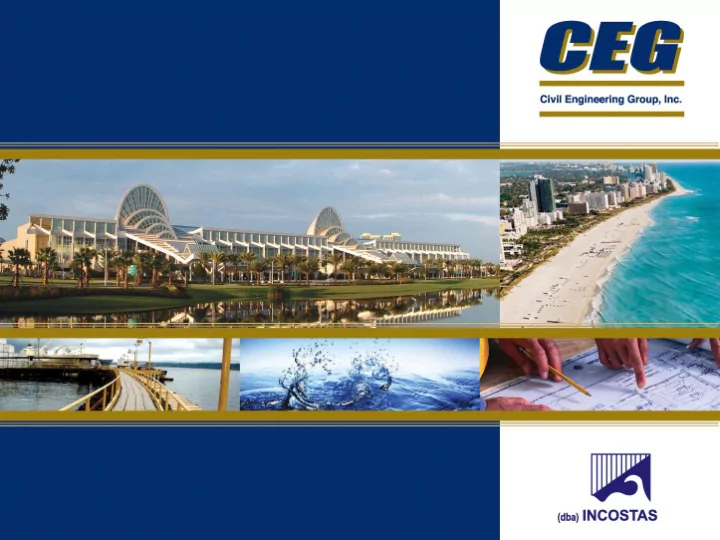

24 th ANNUAL CONFERENCE ON BEACH PRESERVATION TECHNOLOGY February 9-11, 2011 Design of Artificial Beaches and Improvement of Rocky Shore Natural Beaches Ju Juan B. Font a and Al Alberto to Si Silv lva
CONTENTS • Solutions for artificial beaches and improvement of rocky shore natural beaches • Design approaches of artificial beaches • Selected examples of artificial beaches in Venezuela and Chile
ARTIFICIAL BEACHES AND IMPROVEMENT OF ROCKY SHORE NATURAL BEACHES Marine works may be required where: • There are not natural beaches • Existing beaches are in a rocky shore
SOLUTIONS FOR NEW BEACHES OR IMPROVEMENT OF EXISTING BEACHES • Construction of protection structures (arc breakwaters, T- head groins, submerged breakwaters) • Sand nourishment and removal of bottom rocks
DESIGN APPROACHES OF ARTIFICIAL BEACHES • Geometric approaches: empirical bay shape equations (Hsu and Evans, 1989; Hsu, Yu, and Silvester, 2010) • Hydrodynamic approaches: zero net transport (Suárez Bores,1974; Font, Sanabria and Silva, 1974; Broker, 2006; Weesakul et al, 2010)
BEACH PARAMETERS H 2 DEFINICION DE PARAMETROS DE LA PLAYA sb Q H C (a sen 2 a cos ) 0 sb l gb 1 b 2 b y
LONGSHORE TRANSPORT In any generic point of the beach: Q S = Q L + Q G Where: Q S = Net longshore transport of sand Q L = Longshore transport due to breaking wave obliquity Q G = Longshore transport due to breaking wave height gradient According to CERC: 5/2 3 Q 0.11 H sen 2 m /seg L b b H 5/2 - 1 b Q K H m cos G b b y K = 0.2 – 0.7 b = angle of breaking wave front with the shore
From Incostas’ experience from built artificial beaches: 0.7 H 5/2 - 1 b Q 0.3 H m cos G b b y The null transport condition from those equations are: 0 . 7 H - 1 b sen 0.13 m b y For null longshore current (Font, Sanabria, and Silva, 1974) (Equilibrium in radiation stresses) sen α cos H 1 b b sb 0.5 2 H x 3 2 cos sb b b y
LOS CARACAS BEACH, Venezuela
EFFECTS OF SUBMERGED BREAKWATERS • Submerged breakwaters with crest elevation close to mean sea level reduce wave height approximately to half • Breaking wave height is constant along the shoreline; therefore shoreline is straight and parallel to the wave front outside the submerged breakwater • The waves overtopping the breakwater crest will induce strong balance currents in the lee side unless the beach is enclosed by transverse jetties • Combination of submerged and embracing breakwaters may be required to obtain a desired shoreline configuration
CAMURI CHICO BEACH, Venezuela
SELECTED EXAMPLES OF ARTIFICIAL BEACHES IN VENEZUELA AND CHILE
ARTIFICIAL BEACHES IN VENEZUELA Recreational artificial beaches have been built since the 1950s in the Caribbean littoral close to the city of Caracas (Nouel, 1962). It is a mostly rocky shore affected by the trade winds generated waves which are not very high (significant wave height normally between 0.75 m and 1.50 m) but almost without calm periods. Breakwater protection was required for the safety of bathers and retention of nourished sand.
ORICAO CLUB, Venezuela
MARINA GRANDE, Venezuela
MACUTO BEACHES, Venezuela
SHERATON HOTEL, Venezuela (built in 1956)
LOS ANGELES BEACH, Venezuela
CAMURI GRANDE CLUB, Venezuela
LOS CARACAS BEACH, Venezuela
OCUMARE DE LA COSTA BEACH, Venezuela
PALMAR ESTE, Venezuela
ARTIFICIAL BEACHES IN CHILE Similar geological conditions to those found in the coastal area close to Caracas, are present in the Pacific shore in Northern Chile, where sea water temperatures and fair weather are favorable to beach recreation. But since the Pacific wave regime is rougher than in the Caribbean, the Coastal Engineering challenges were greater and physical hydraulic modeling was used in most cases. Several artificial beaches have been built in the past decade and are successfully performing.
El Carboncillo Beach, Chile HYDRAULIC MODEL – NATIONAL HYDRAULICS INSTITUTE
CARBONCILLO, ANTOFAGASTA, Chile
MUNICIPAL ANTOFAGASTA BEACH BEFORE IMPROVEMENT WORKS
MUNICIPAL ANTOFAGASTA BEACH - DESIGN
MUNICIPAL ANTOFAGASTA BEACH AFTER IMPROVEMENT WORKS
TROCADERO, ANTOFAGASTA, Chile
TROCADERO, ANTOFAGASTA, Chile
TROCADERO BEACH, ANTOFAGASTA, Chile
COVADONGA BEACH HYDRAULIC MODEL NATIONAL HYDRAULICS INSTITUTE
CONCLUSIONS Artificial beaches are a valid solution for recreation and shore protection Geometrical and hydrodynamic approaches could be used for design of artificial beaches Design of artificial beaches should carefully provide the desired plan form as well as a safe and comfortable environment to bathers Mathematical and physical models are useful tools for design of artificial In Venezuela and Chile there are many good examples of artificial beaches that are functioning properly
THANK YOU
Recommend
More recommend